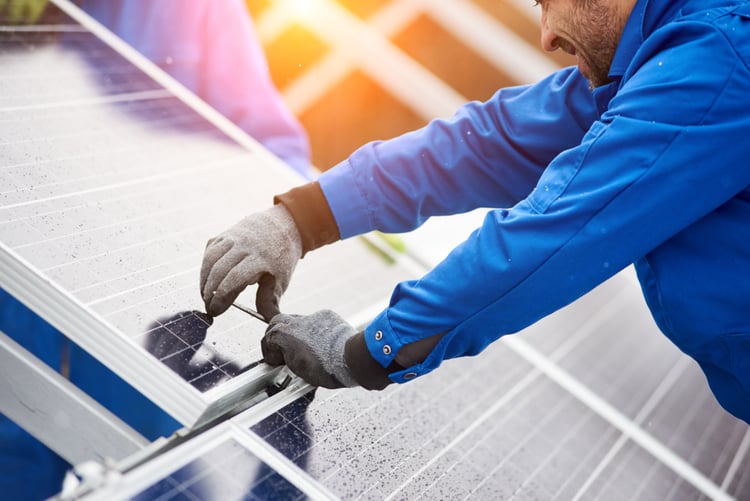The US Solar Industry in 2022: Main Threats and Opportunities

If you follow our blog posts and renewable energy news in general, you have probably read about the recent growth of solar power in the US. Photovoltaic technology represents over 50% of the generation capacity added in 2021, and the US surpassed 100 gigawatts of solar capacity during the first months of the year. If this trend continues during the next five years, the installed capacity could reach 250 - 300 GW by the end of 2026, according to projections from Wood Mackenzie and the Solar Energy Industries Association.
Considering solar power for your building project? Get a professional assessment and design.
In spite of the positive outlook, supply chain issues are causing uncertainty for the US solar industry in the near future.
- Global supply chains are saturated, and there are dozens of container ships waiting for their turn to dock and unload on the main US ports. This is delaying all types of deliveries, including solar components.
- Supply chain issues have been combined with policy uncertainty, especially the recently dismissed petition for anti-dumping and countervailing duties, and the withhold release order for silicon products manufactured by Hoshine.
However, the Build Back Better Act could give a major boost to the US solar industry, restoring the 30% federal tax credit that was available before 2020. The tax credit would also be extended until the end of 2026, no longer expiring in December 2023. Wood Mackenzie and the SEIA have forecast a 31% increase in solar installations under this scenario, compensating for the 25% slowdown caused by supply chain issues.
Build Back Better Act: Proposal to Increase and Extend the Solar Federal Tax Credit

The Investment Tax Credit (ITC) first became available in 2006, and it has been one of the main incentives for solar power in the US. Before 2020, homeowners and businesses who installed solar panels could claim 30% of their costs as a federal tax deduction.
- The benefit was reduced to 26% in 2020, and there is another reduction to 22% planned for 2023.
- Under the current schedule, the ITC disappears for the residential sector in 2024, and only a 10% tax credit will remain for businesses who go solar.
However, the Biden Administration plans to restore the 30% solar tax credit with the Build Back Better Act, while extending the benefit until the end of 2026. This would give a major boost to the solar industry, increasing installations by 31% according to the latest SEIA quarterly report. The proposed extension would also change how the Investment Tax Credit (ITC) works, and some projects would be eligible for deductions higher than 30%.
The following table summarizes the proposed changes to the solar federal tax credit, according to the US House version of the Build Back Better Act (November 19, 2021). This could change in the final version after going through Congress, but the outlook is very promising:
|
Solar Power Project Conditions |
Federal Tax Credit |
|
Residential solar power and commercial/utility systems below one megawatt of capacity. |
30% |
|
Solar projects over 1 MW, meeting prevailing wage and apprenticeship conditions. |
30% |
|
Solar projects over 1 MW, not meeting prevailing wage and apprenticeship conditions. |
6% |
|
Solar projects over 1 MW, meeting only domestic content requirements. |
8% |
|
Solar projects over 1 MW meeting all three conditions: prevailing wage, apprenticeship, domestic content. |
40% |
|
Additional tax credit for solar projects in low-income communities. |
+10% |
|
Additional tax credit for solar projects that qualify as low-income economic benefit projects |
+20% |
The BBB Act prioritizes job creation and products made in the US. The federal tax credit is much lower for megawatt-scale projects that fail to meet these conditions, but it also increases significantly if they comply. A solar project could potentially qualify for a 60% tax credit for meeting all possible conditions (prevailing wage, apprenticeship, domestic content, qualifying as a low-income economic benefit project).
Managing Supply Chain Issues in the US Solar Power Industry
Slow supply chains are having a negative impact on solar installation in the US: projects are being delayed, and installed costs per watt are on the rise. The AD/CVD petition would have caused a considerable price increase for solar components from some manufacturing hubs in Asia, but fortunately it was dismissed.
At the same time, the WRO is limiting imports from the Xinjiang region in China, where Hoshine Silicon Industry Co. operates. Solar developers can reduce the risk of shipment detention by demonstrating that their imported components are from outside of the Xinjiang region. Another viable strategy to deal with supply chain issues is using solar brands that are manufactured locally, since there is no need for marine transport.

Michael Tobias
Michael Tobias, the Founding Principal of NY Engineers, currently leads a team of 150+ MEP/FP engineers and has led over 4,000 projects in the US
Join 15,000+ Fellow Architects and Contractors
Get expert engineering tips straight to your inbox. Subscribe to the NY Engineers Blog below.

